All cats need a cat scratcher–but getting to your cat to love that scratcher (perhaps more than she loves scratching the arm of the couch!) may take a few steps. We’ve got tips for you on choosing the best cat scratcher for your cat’s scratching style and learning how to get a cat to use a scratching post once you have it in your home!
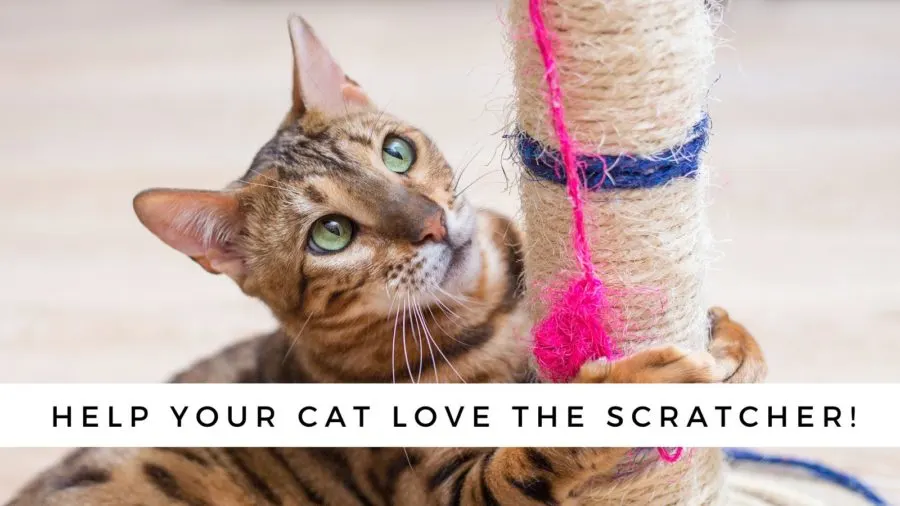
Why Cats Need a Scratching Post
As cat lovers, we all know one simple truth: cat scratches happen. A natural part of cat behavior, cat scratches help your cat communicate with other cats, leaving a two-fold message. First, he’s left a visual cue, the scratch itself, that he’s present. But he’s also leaving a message that’s invisible to you, pheromones that leave a territory message to other cats that this spot is taken.
That’s all fine and good–except when those messages are being left on your favorite chair or sofa.
But aligning your cat’s need to communicate those territorial messages–and your need to keep your furniture intact–is easily done with just some simple redirection: enter the cat scratcher or scratching post.
Scratching is as natural to a cat as grooming. Not only does scratching help your cat remove the outer dead layer from her claws, but it also serves to help provide your cat with a good stretch for her shoulders and back.
Unfortunately, though, sometimes that territory consists of your furniture or other objects in your home that you’d prefer remain unmarred.
“Destruction caused by scratching is a troublesome problem, yet this behavior is a completely natural and instinctual way that cats use to keep their claws groomed,” explains Jennifer Couillez, product marketing manager at Petmate, a company that makes several types of scratchers.
“By providing your cat with a dedicated cat scratcher, you protect the investment of your furniture and home while allowing your cat to keep their claws healthy. It is important to introduce your cat to the scratcher early to avoid damage to your home.”
Choosing a Type of Scratcher
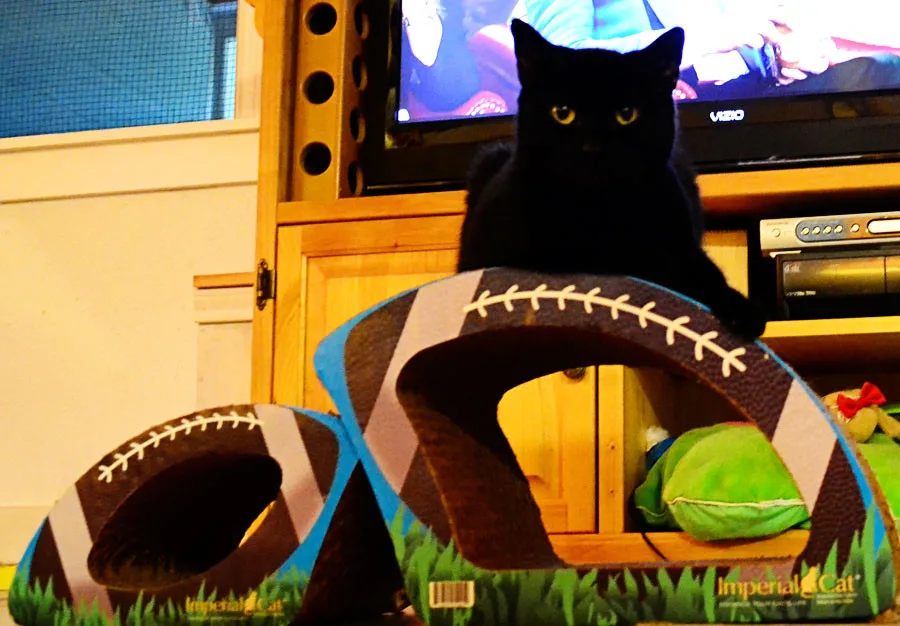
Cat scratchers come in a variety of textures and materials, from carpet to cardboard to sisal, and in a variety of styles, from horizontal to vertical scratchers. Just like us, each cat has his own favorites–and, just like us, sometimes it takes a little nudge to make a change in behavior.
Before you run to the store to purchase a cat scratching post, watch your cat to learn her particular scratching style.
- Does your cat like to stretch up and scratch on the edge of vertical edge of the couch or on the doorway? You’ll then want to buy her a vertical scratcher or a scratching post, either one that’s taller than her or that hangs or secures to the wall for vertical scratching.
- Does your cat prefer to stand on the rug or the arm of the couch and scratch with her arms below her? In this case, you’ll want to purchase a horizontal scratcher that she can stand on and scratch.
Mary James, co-founder of SurfPet, which sells a variety of types of cat furniture, recommends making sure a vertical scratcher is tall enough for your particular cat.
“Cats generally prefer to be able to fully stretch, so a tall post 24 to 32 inches works best. If your cats can’t stretch out far enough, or can’t get a firm grip, they may go right back to using your sofa arm as their favorite claw sharpening station.”
James also recommends purchasing a post with a wide base so the post will not wobble as the cat uses the scratcher.
Choose the Right Scratching Post Material
Scratchers–from scratching posts to flat scratchers–are made in a wide variety of materials: sisal, jute, cardboard, carpet, and more.
Try to determine if your cat likes soft or rough surfaces for scratching. You might need to purchase a couple of scratchers and see which she prefers.
Place the Scratcher in the Right Place
Besides marking an item she likes – such as your couch – your cat may also be marking a location as her own.
If you consistently see your cat scratching a particular piece of furniture, place the new scratcher adjacent to that furniture!
Use Catnip to Lure Your Cat to the Scratcher
About one-third of the cat population doesn’t care about catnip, but the remainder will go crazy for this member of the mint family.
Sprinkling dried catnip on the new scratcher will let your cat know that this is her scratcher. If you don’t like the messiness of dried catnip, you can also find catnip sprays and stickers that will convey the same message.
How to Redirect Your Cat’s Scratching to a Cat Scratcher
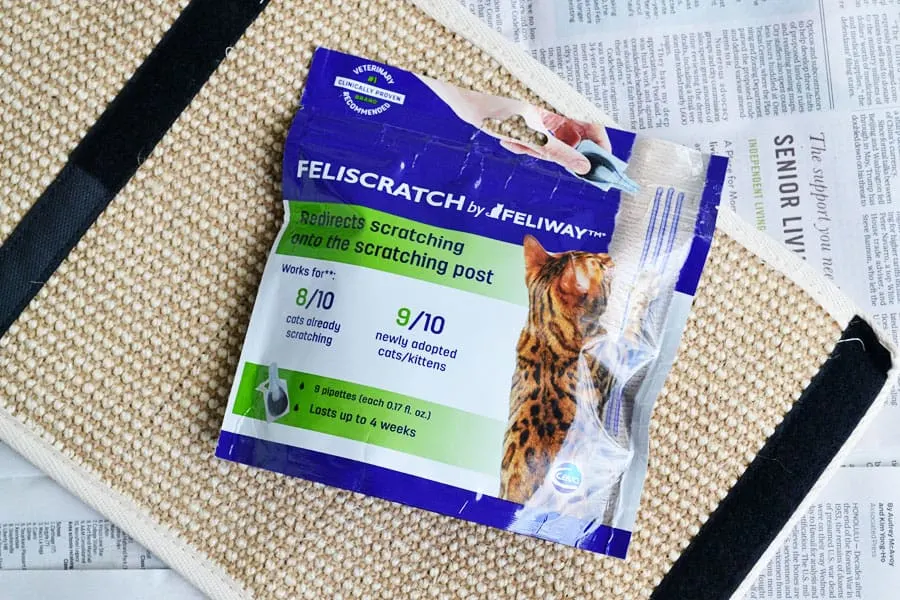
FELISCRATCH by FELIWAY® is designed to help redirect your cat’s scratching to a scratching post. Our cats have several well-loved and well-used cat scratchers–but since last winter we’ve had one particular scratcher that no one has been interested in using.
It’s designed to wrap around the leg of a chair or piece of furniture (we use it on an old family piano)…but no one has looked at it twice since I bought in February.
And so I decided to give FELISCRATCH by FELIWAY® a try on this scratching post. This liquid is applied to the scratching post to help encourage the cat to use the scratching post as the place for his territorial marker. Each package contains nine pipettes, enough for a month of redirection.
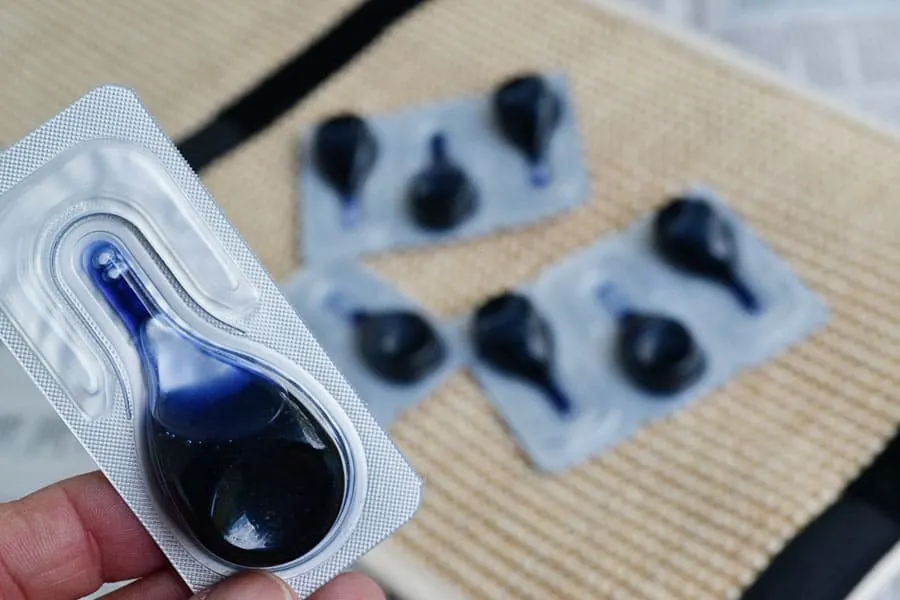
Application of FELISCRATCH by FELIWAY is super simple: place the scratcher on newspaper or in the sink and apply two or three vertical lines of the liquid. I took the scratcher out on the porch, away from my feline “helpers”, and snipped the pipette to begin application:
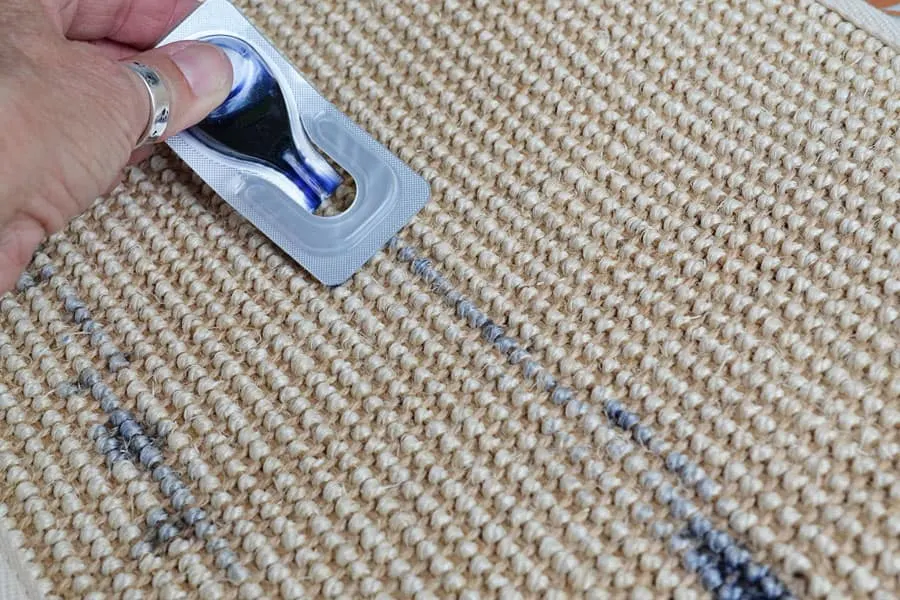
As you can see, there is a stain to the liquid, one that will give your cat the visual cues he needs to help make this behavior transition to the scratcher:
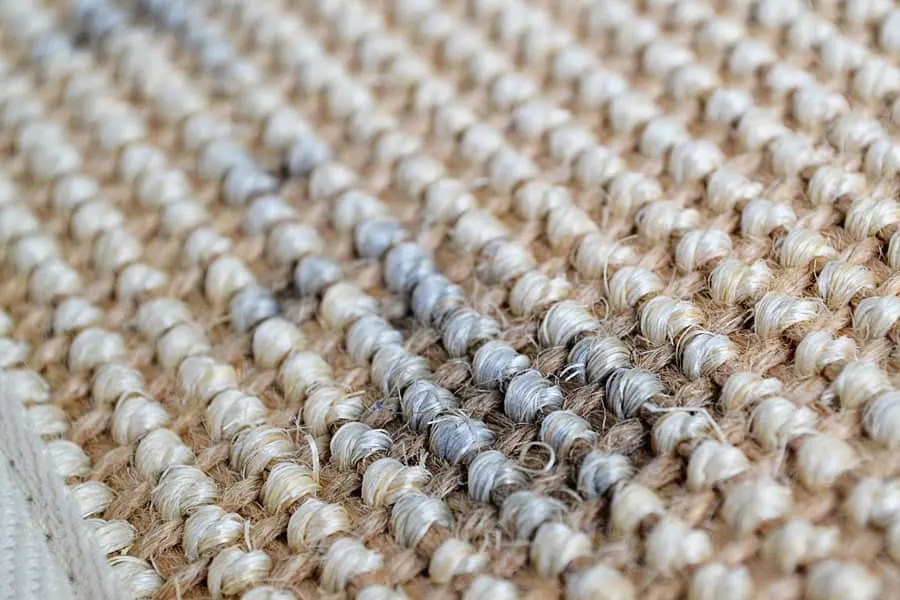
Once I was done with the application, I left the scratcher on the porch for a few minutes to dry (guarded by our cast iron kitty).
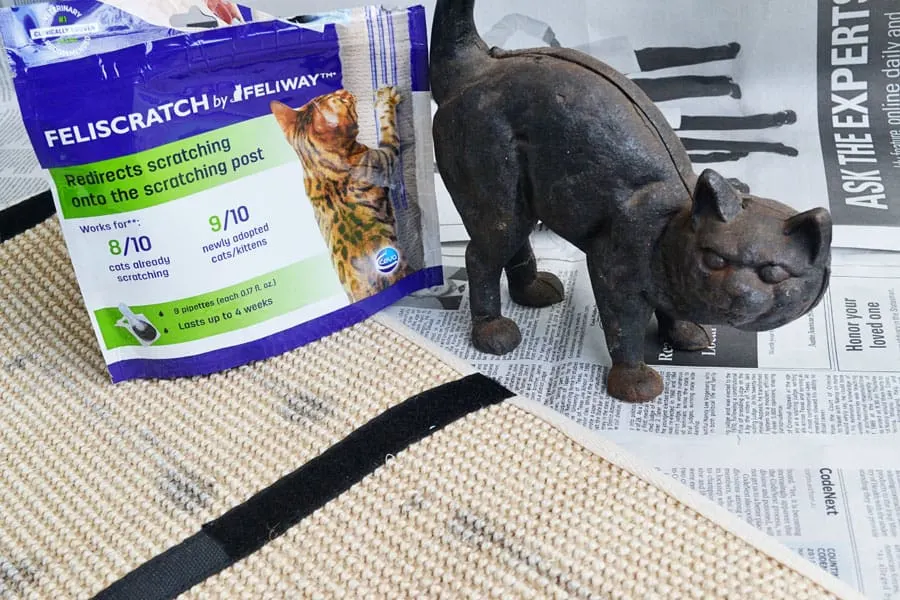
Once dry, I brought the scratcher in the house and wrapped it around the leg of the piano. As you’ll remember, this is a scratcher that no one showed any interest in–since I put it up February!
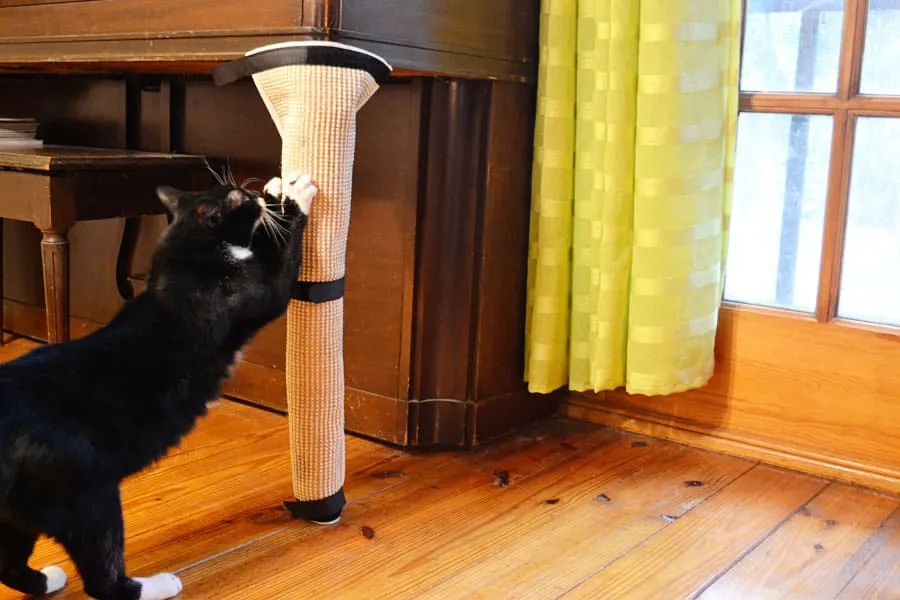
Lucky was the first to see the now-treated scratcher, and he was on it like a flash. Soon Jetty came to see what all the fuss was about…
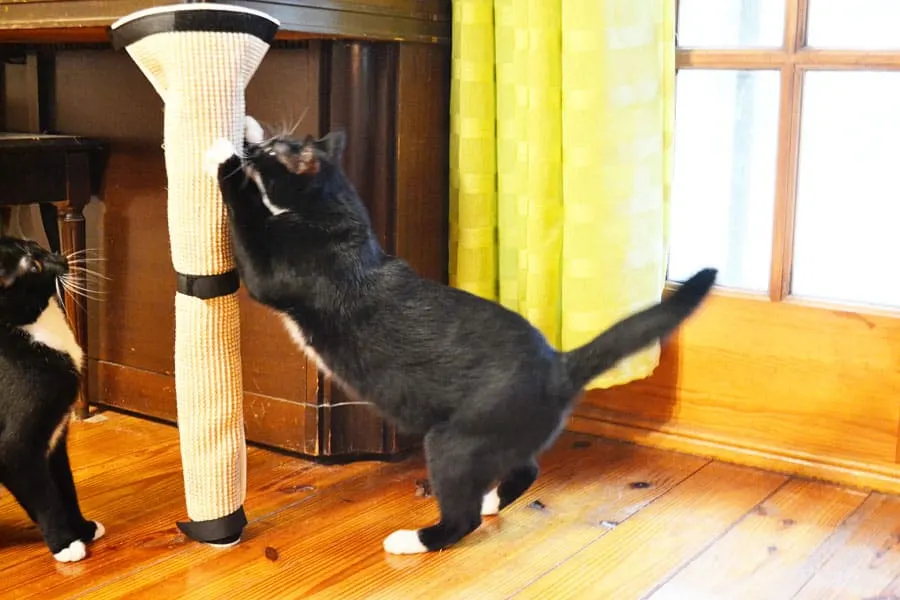
Lucky was not in a sharing mood, though, and continued to show off his best moves…
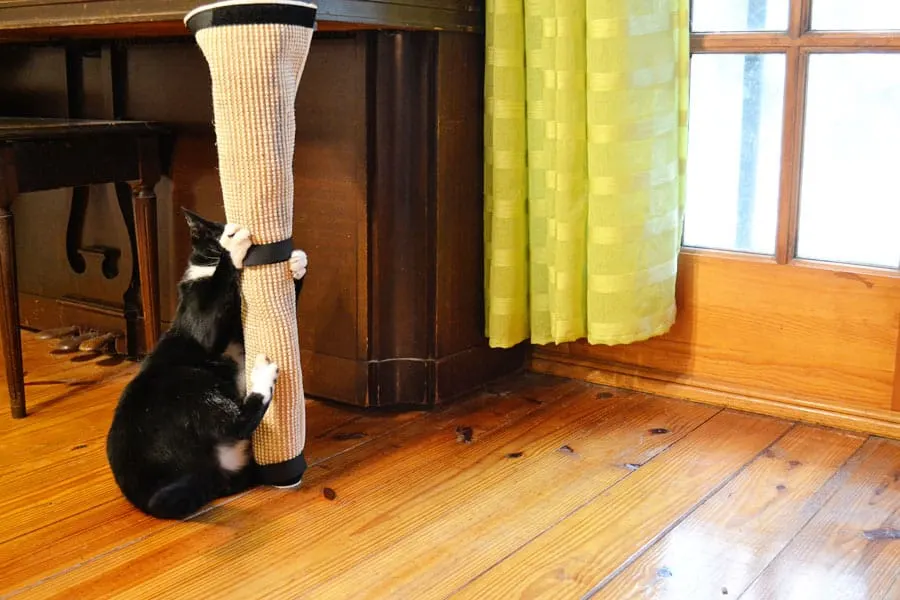
FELISCRATCH by FELIWAY® made this scratcher a huge hit in our house. As I mentioned, the package contains enough applicators for a month of coverage:
- Week one: one pipette per day
- Week two: no application
- Week three: start the week with one application
- Week four: start the week with one application
As with people, a month is enough time to change a cat’s habits–and redirect that completely natural scratching behavior to a place that will keep you and your cat happy. And if you think your cat needs some additional help, FELIWAY® CLASSIC Spray can be used on the furniture that your cat should NOT spray, helping to create a sense of familiarity and security.
With these easy steps, it’s easy to help your cat learn to use a scratching post. Scratchers are a great way to appeal to your cat’s natural instincts, provide her with both entertainment and exercise—and save your furniture in the process!
Related Posts
Help Your Cat Love the Cat Scratcher!
Review: Imperial Cat Football Scratch ‘n Shapes
Comforting Your Cat When You Bring a New Pet Home #FeliwayCat
Pin it to remember
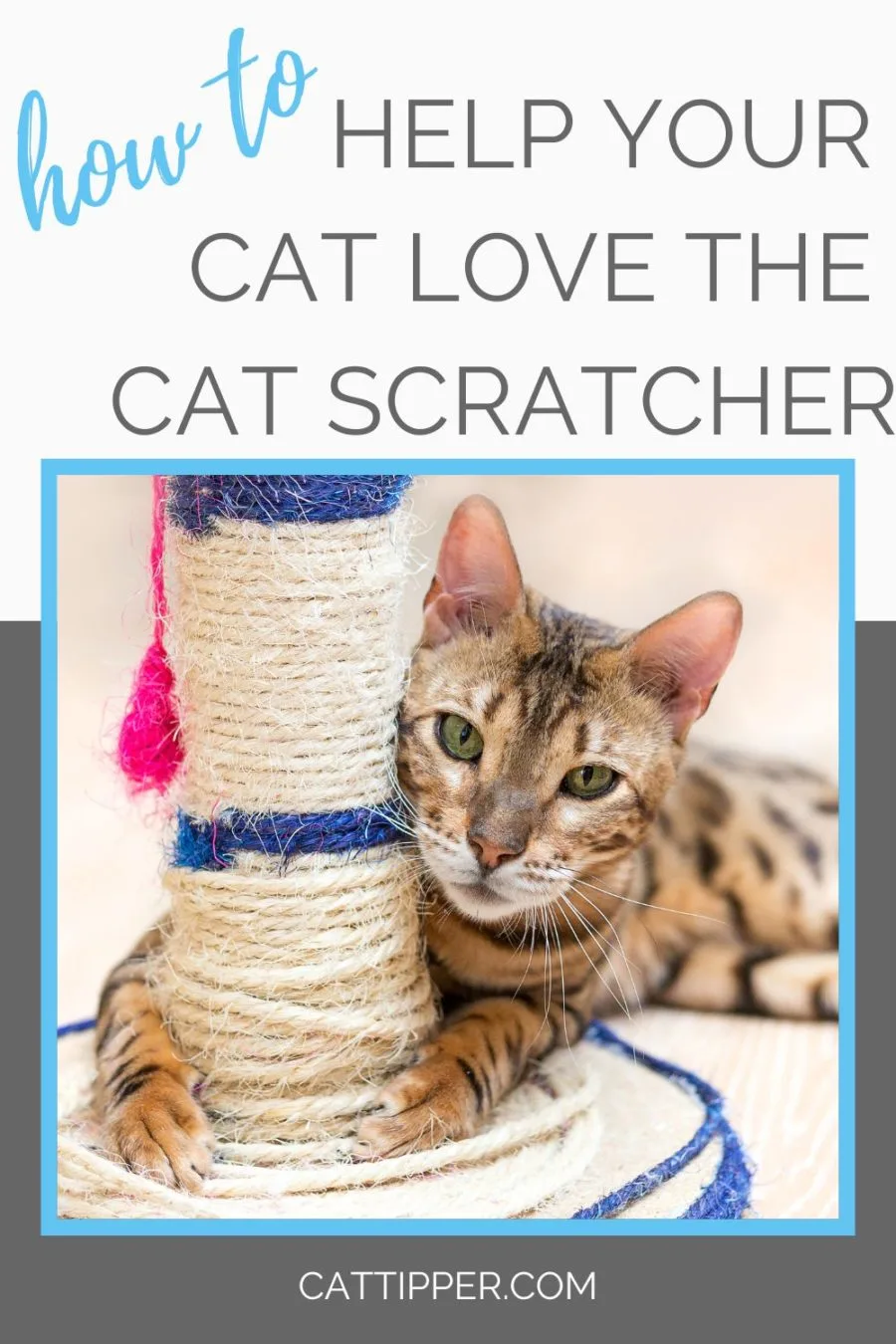
- 🎉 GIVEAWAY: Lord of the Pets Portrait of Your Cat! - November 26, 2024
- Review: Lord of the Pets Cat Portraits! - November 26, 2024
- Cat Adoption: FAQ You Might Have - June 28, 2024
